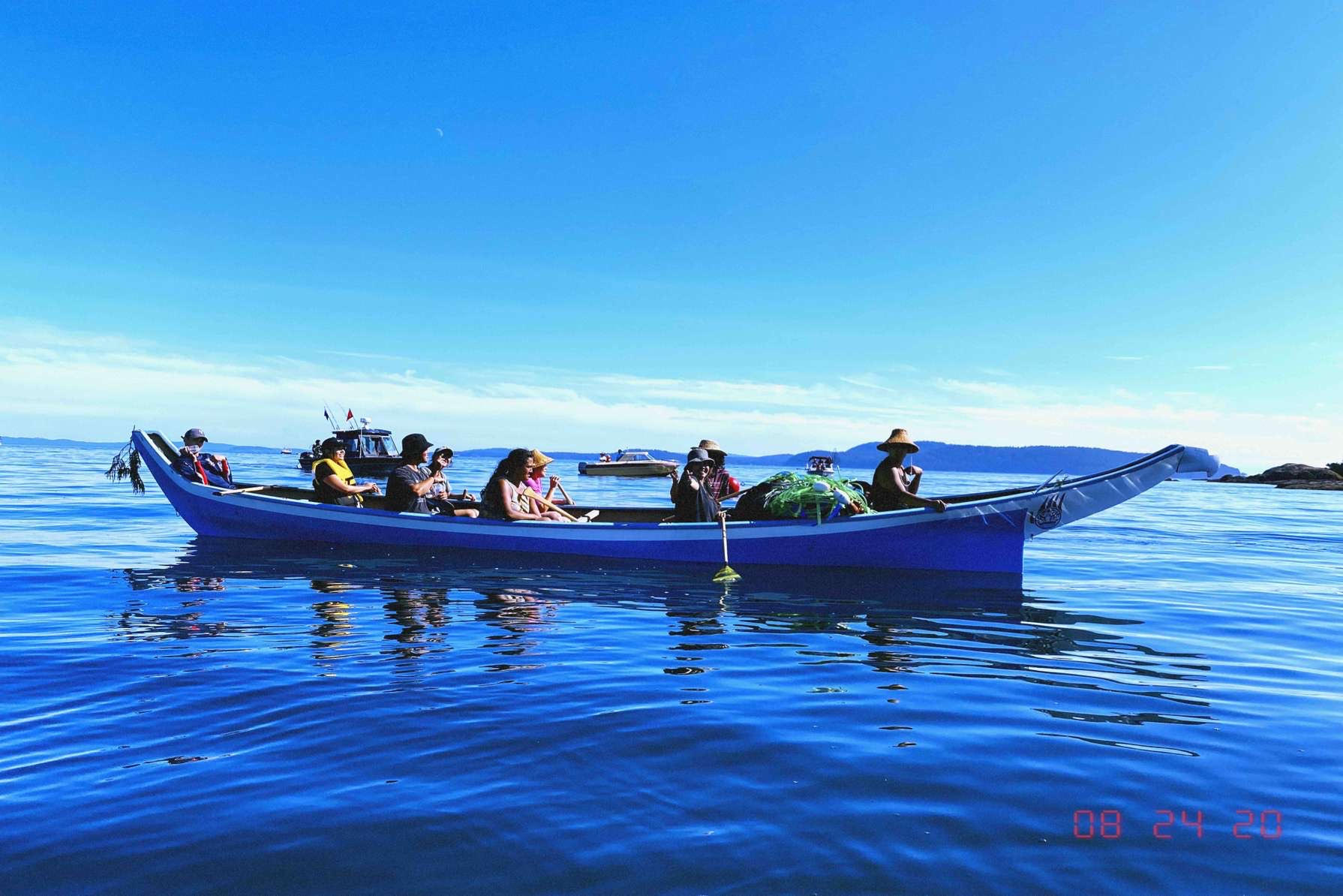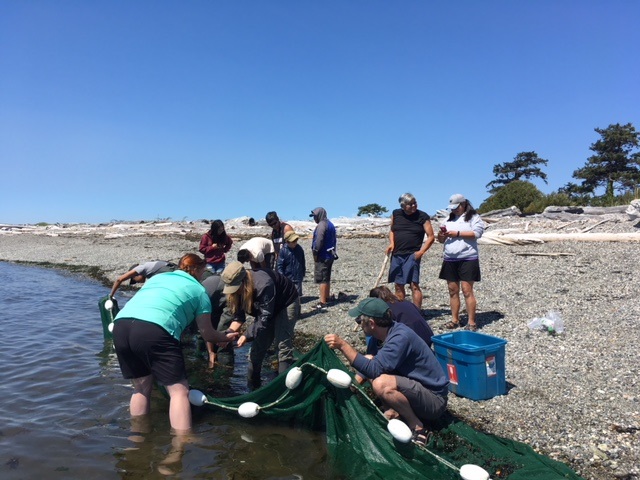Darlene took this photo yesterday (Oct. 1, 2019). We think it is a spotted ratfish (Hydrolagus colliei). They are more closely related to sharks than fish. The Wiki page reports that they move closer to shore in the spring and fall, but can be found up to 1 km deep in the summer.
JOIN US for a Community Celebration highlighting the Reefnet Fishery – September 22, 2018
On August 9th, 2014, the W̱SÁNEĆ Nation went reef net fishing to reclaim a practice that the colonial government outlawed a hundred years ago. Nick Claxton (XEMŦOLTW̱), Tsawout community member and PhD. Candidate in UVic’s Department of Curriculum and Instruction has made it his life’s work to revitalize the reef net fishery (SX̱OLE) in his community. Over the past year, he built a reef net model alongside students and teachers in a local school, ȽÁU, WELṈEW̱ Tribal School. The project was so successful that teachers throughout the school—math teachers, science teachers, socials teachers—began to teach their subjects through the model net.
Meanwhile, with the help of their relatives at the Lummi Nation (Washington, US) who had recently undergone a process of reef net resurgence, Nick and members of the W̱SÁNEĆ Nation began to build the first W̱SÁNEĆ-made reef net in over a hundred years. In an act that will go down in history as the resurgence of a core part of the W̱SÁNEĆ Nation’s social, economic, spiritual, and educational society, the reef net was set at a hereditary fishing location (SWÁLET) off of Pender Island on August 9th, 2014.
This short video will give you a sense of the power of that day and what it means to “carry on our fisheries as formerly,” as agreed to in the Douglas Treaty signed by the Saanich people in 1852.
Watch on Youtube – To Fish As Formerly: W̱SÁNEĆ Nation Brings Reef Net Fishing Back After 100 Years
Songhees Academic Youth Leadership had a 2-day Science Camp at the University of Victoria. Dr. John Taylor lined up a bunch of amazing mini-workshops for our youth.
SAYL working with the University of Victoria to collect sand and water samples to do lab work with Matt Miller and Dr. John Taylor. We started the morning learning from Dr. Richard Dewey taught our youth about the relationships between the tides and the moon and how that affects our food systems. Then we met with Matt Miller and Dr. John Taylor to start collecting water and sand samples to test for micro-plastics. After we collected our samples we went back to the University of Victoria to use their Biology Lab. Here we were able to prepare our samples for lab work.

We began our day on the beaches of Cadboro Bay.
Dr Richard Dewey from Ocean Science Network taught SAYL about how the tides are affected by the moon.

Maeve Lydon watches over the presentation with Dr. Richard Dewey with some Songhees Youth – Phoenix Clark, Rylan Pelkey and Rayn Cook-Thomas.

Songhees youth collecting sand samples at various distances from the shoreline at Cadboro Bay. We will take these samples back to the UVIC Biology Lab to test for micro-plastics.

Angelina Sam and Linda-Jane Fisher labelling sand samples to bring back to the biology lab to test for micro-plastics.

Dr. John Taylor and Maeve Lydon have been very instrumental with assisting Songhees Academic Youth Leadership with their studies on the land.
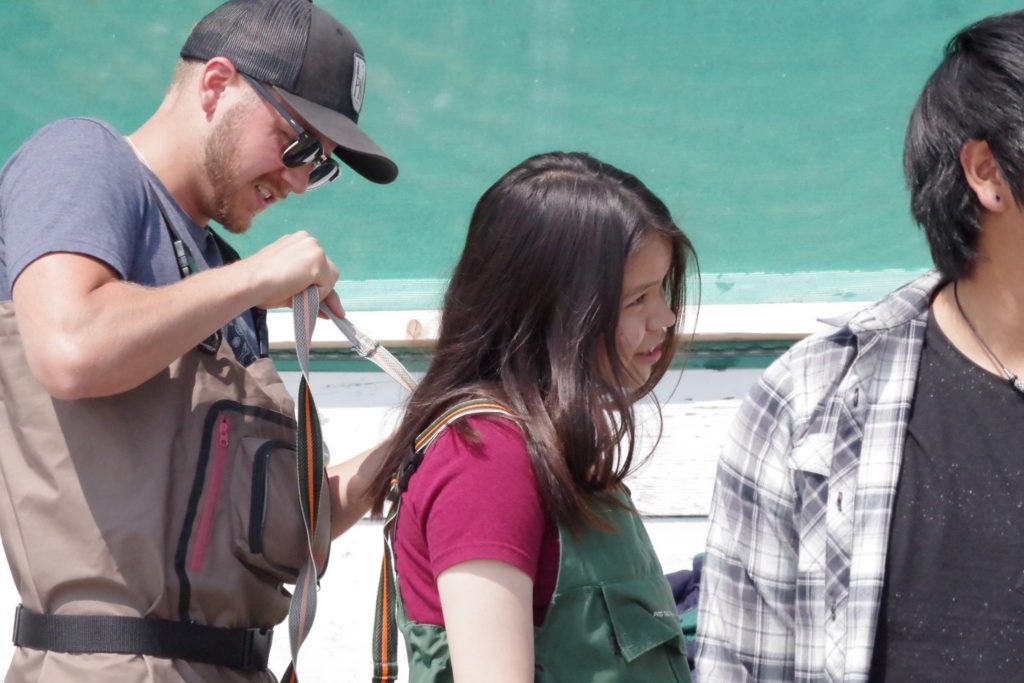
Matt Miller is suiting Cynthia Sam up for collecting water samples in Cadboro Bay.

Cynthia Sam and Matt Miller collecting water samples in Cadboro Bay for testing of micro-plastics.

Angelina Sam collecting water samples with Matt Miller in Cadboro Bay. Different parts of the bay were gathered.
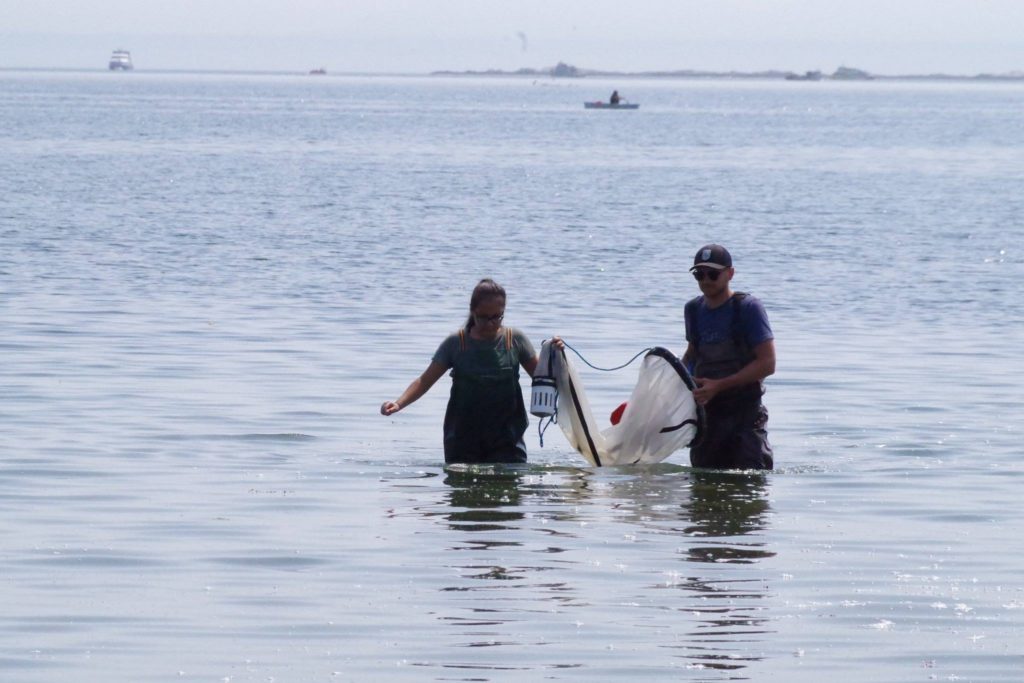
Angelina and Matt bringing in some water samples.

Angelina Sam collecting the water sample with Matt Miller from UVic.

Eugene Sam supervising all the the proceedings of the Songhees Academic Youth Leadership – Living Science Lab.
Our Songhees Youth interviewed our Elders in both Year 1 and Year 2 of the SAYL – Living Science Lab project.

CRD’s Erich Kelch and Keir Cordner from First Nations Health Authority made this trip possible. Erich drove us out to T’souke. Having Keir there, allowed our youth to bring the harvested food to our licenced facility.
They joined us in a Traditional Foods harvest, with the permission and proper protocol of the T’souke Nation.

Elder’s Janice and Joe George brought us out to harvest some food. It was great spending time with our family.
We learned a lot from them. They taught us about our own seasonal calendar – planting, monitoring and harvesting.
Cynthia Sam, Eugene Sam, and Phoenix Clark want to go back out on the land with Joe and Janice.

Joe (Elmer) George talking to our youth about proper practices and protocol when it comes to harvesting traditional foods on other peoples territory.
Our youth gifted T’souke Nation for allowing us to teach our youth about traditional food systems.

Joe George, Keir Cordner, Janice George and Erich Kelch.

Songhees Youth, Cynthia Sam, Eugene Sam, Phoenix Clark join Joe and Janice George and Keir Cordner and Erich Kelch.

We found a lot of oysters, clams, some chiton and a crab. It was a great experience for our youth who have not had many opportunities to collect seafood in the City of Victoria.

Chiton, also know as rock sticker.

Erich holds a small crab that we had to release because it was too small.

T’souke Nation has amazing beaches and scenery. Our youth thoroughly enjoyed their time out there.

While we were out there, we saw a lot of amazing wildlife. On our way back to our van, we saw this.

Songhees Elder Skip Dick speaking with Cynthia Sam about our history and language.
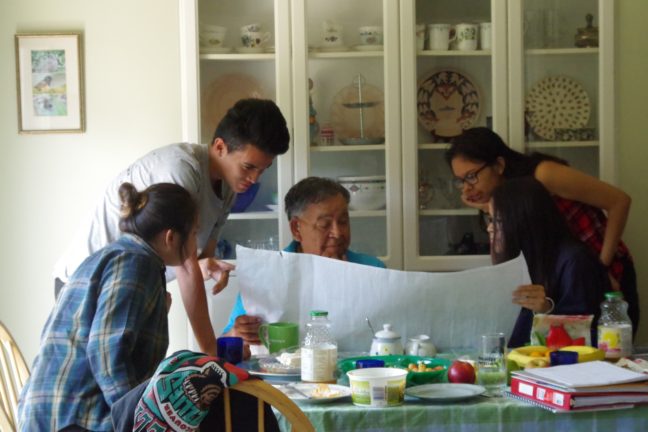
Songhees Youth and Elder Skip Dick looking at the traditional foods map that our youth mapped with Cheryl Bryce and Phoenix Clark.

Frankie Taylor, Rayn Cook-Thomas and Skip Dick.

Skip Dick, Cynthia Sam and Linda-Jane Fisher.
Each year, Songhees Academic Youth Leadership goes to our islands to do some historical, biological and anthropological work with Songhees and UVIC experts.

Standing around an ancient longhouse foundation with Songhees youth, researchers and Songhees knowledge holders.
Morgan Black shared so much of what she’s learned in her studies. The youth greatly appreciated learning all that she has to share.
Jordan Dick, Frankie Taylor and Lyle Henry taking in all they can in our outdoor classroom.

Learning about traditional foods, native plants, and invasive species from knowledge keeper Cheryl Bryce.
The youth greatly appreciate all the stories and knowledge Cheryl shares with the group.


Archaeologist Darcy Mathews sharing his passion about Tl’iches amazing capacity as a classroom.

Songhees youth and elder overlooking what was very likely a traditional reef net fishing area

Songhees Youth listening to Darcy Matthews and Cheryl Bryce talk about our history and culture.

Seining with Morgan Black from the University of Victoria.
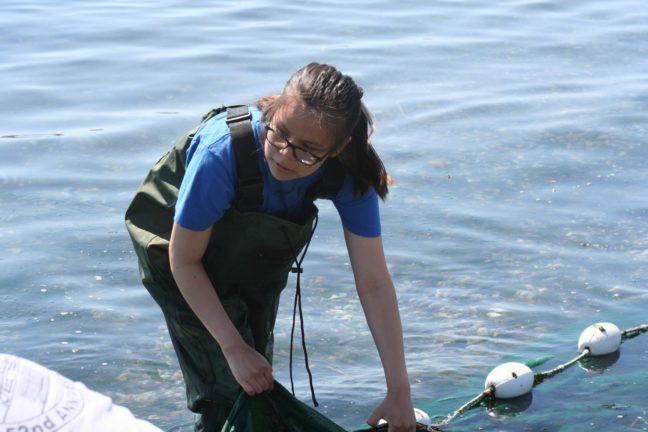
Cynthia Sam seining for marine species.

Linda-Jane Fisher seining for marine species.

Phoenix Clark seining for marine species.

Frankie Taylor and Jordan Dick seining. It was super fun watching the youth out in the water.

Jordan Dick dragging the net along the bottom to catch some marine species.
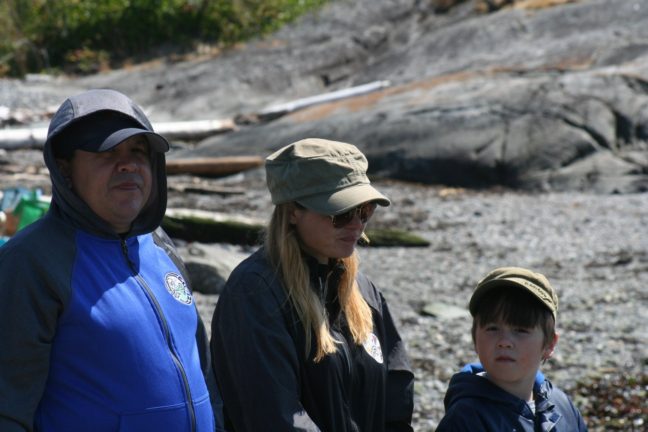
Chief Ron Sam, Kathleen Bryce and son Ethan Sam enjoying their time on the island with our youth and UVIC staff.

penpoint gunnel

shiner perch
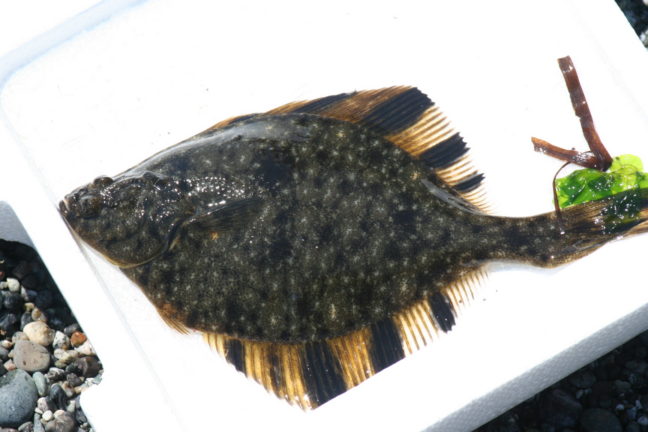
starry

sculpin
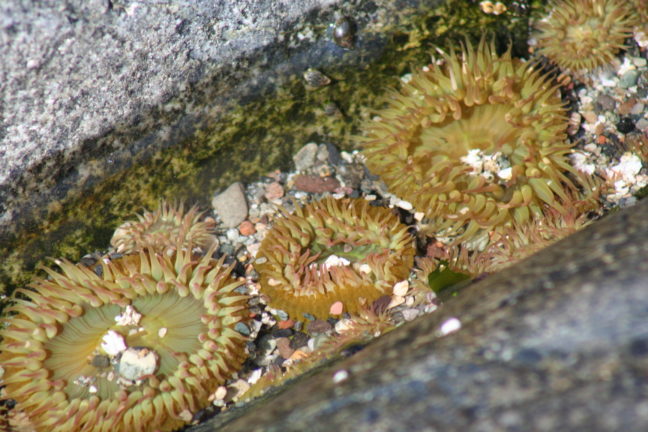
aggregating anemone

Chief Ron Sam and family leaving back to the mainland. It was such an honour to have him join our youth on this trip.
Living Lab participated in National Aboriginal Day – LAU WEL NEW Tribal School’s Cultural Day sponsored by PEPAKEN HAUTW who have been leading the Reefnet – willow restoration project. Sharing a Clam Bar B Q – marine life tent with Earl Claxton Jr was Morgan Black, Living Lab Science Coordinator. Many children, teachers, elders and community members participated in the many environmentally–focused activities.
Event Photos:

Morgan and Child – Clam Bar q’ing – June 20 2019

Morgan, Judith, Earl and Erich – Living Lab Team Photo – June 20, 2019

Morgan and Earl – June 20, 2019

WSANEC Elder and Child (Pollinator!) – June 2019
On July 11th Living Lab team members Florence Dick and Darlene Joseph ( Songhees Nation) , Earl Claxton Jr, Nick Claxton and Tiffany Joseph ( WSANEC) along with John Lutz (UVic History), John Taylor ( Biology), Judith Lyn Arney ( PEPAKEN HAUT’W) and Maeve Lydon ( Staff) had field trip / learning day out at Pender and Salt spring to visit the traditional territories of the WSANEC (Poet’s Cove- Pender Islands) and reefnet fishery site, to Burgoyne Bay ( XWAAQUAM) Cowichan Territory and Red Fish School of Change field school. The purpose was to come together as a community of practice to learn about current restoration and resurgence efforts on the land and for the reefnet fishery and to meet collaborators from the TETACES Climate Action Project on Pender Islands and the Redfish School of Change at XWAAQUAM.
Event Photos:

Coast Salish Gathering @ XWAAQUAM) (l to r) Joe ( Cowichan/ Settler), Darlene (Songhees), Earl (WSANEC), Tiffany (WSANEC), Nick (WSANEC) and Florence (Songhees)

Redfish School of Change Circle – XWAAQUAM

Earl and Nick – Pender Island- Poets Cove Reserve Boundary

Earl, Judith and Nick – Pender Island Reefnet – Reserve Site
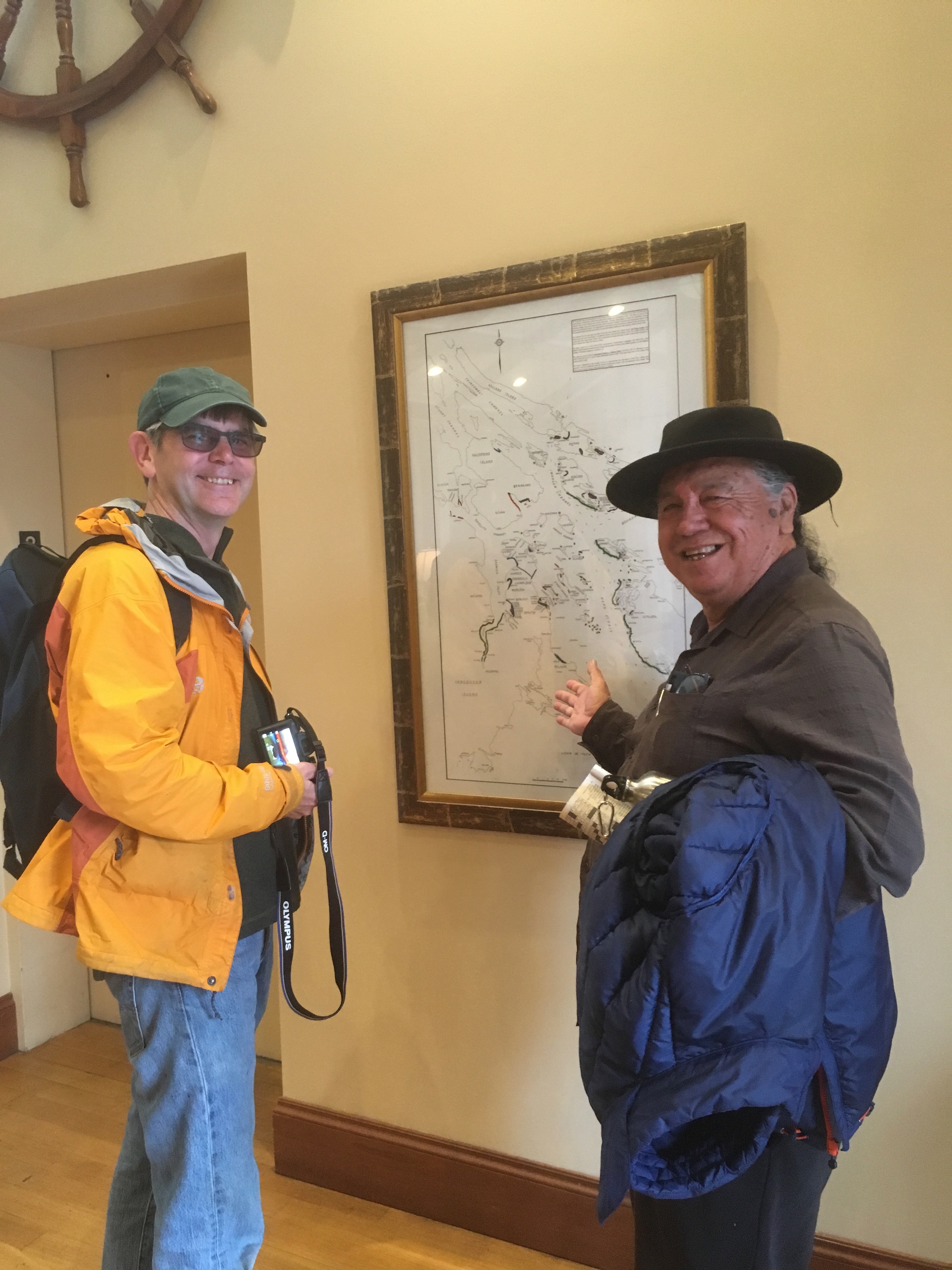
John Lutz and Earl Claxton Jr with Saltwater People WSANEC Map

